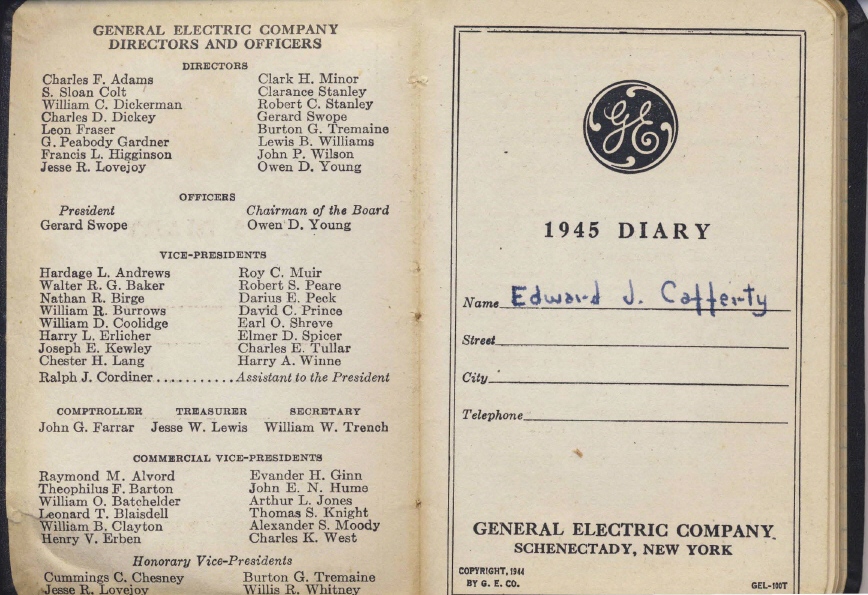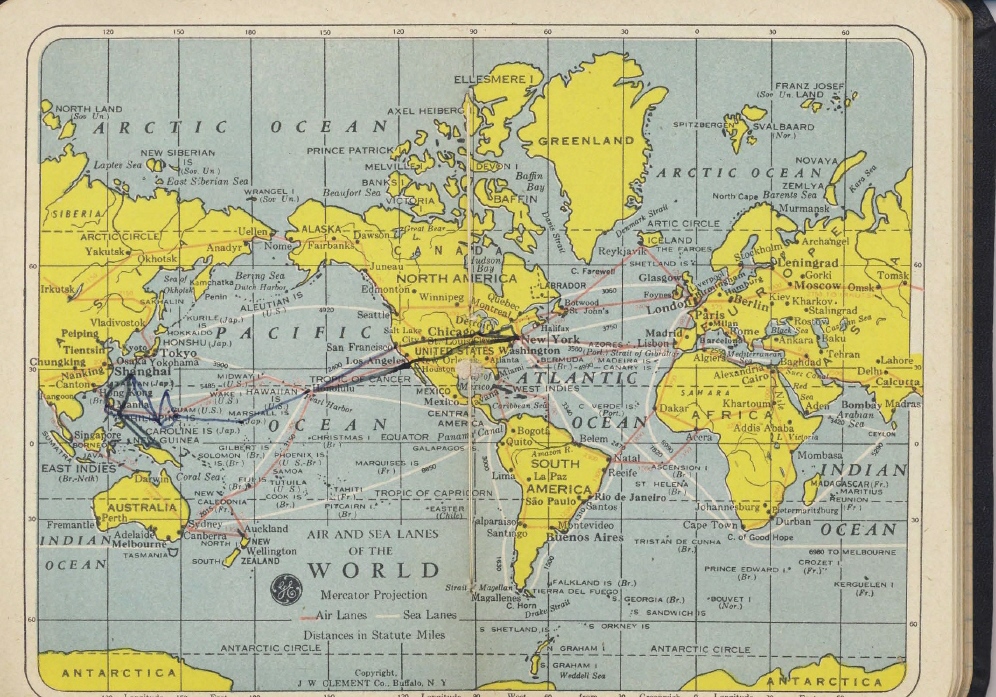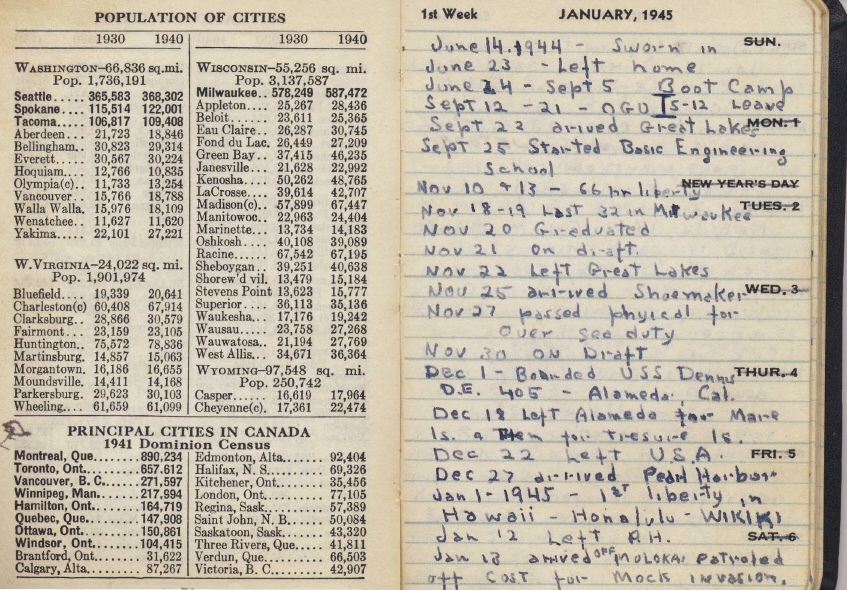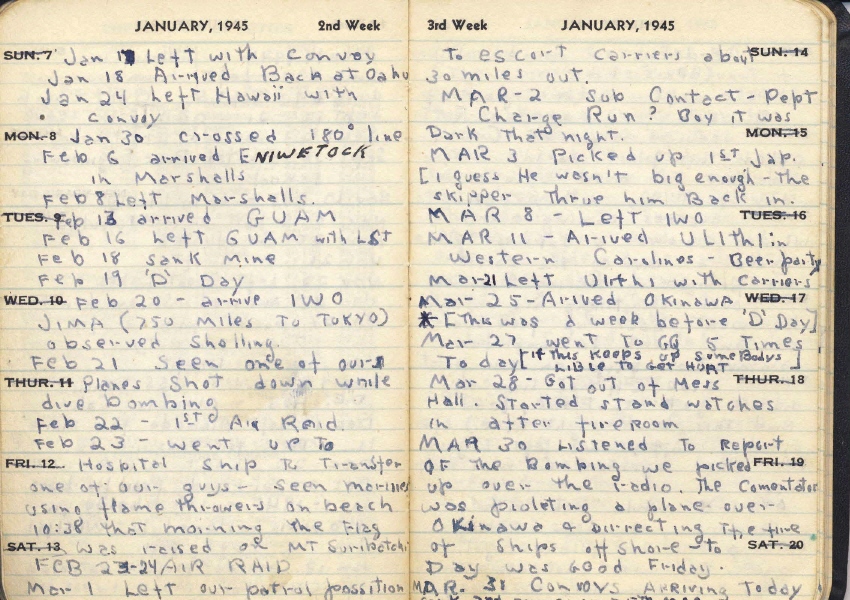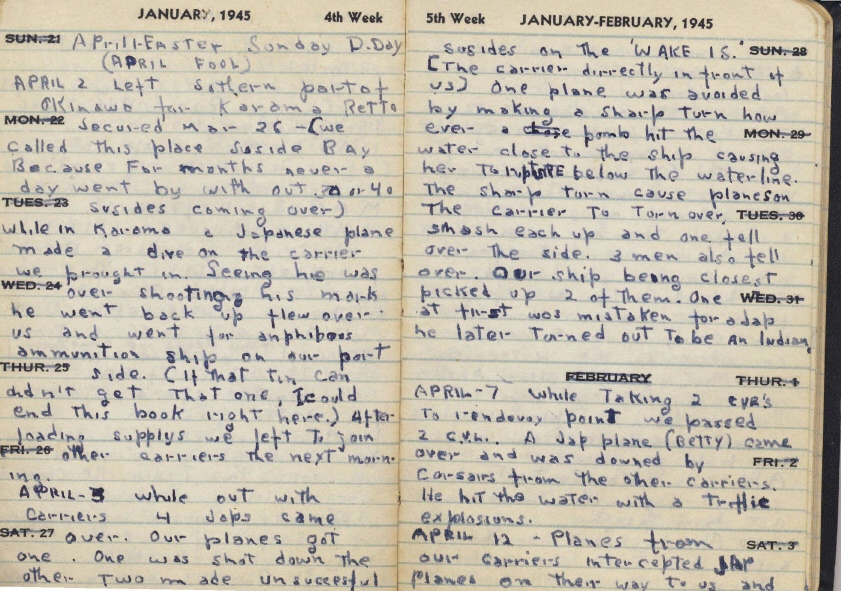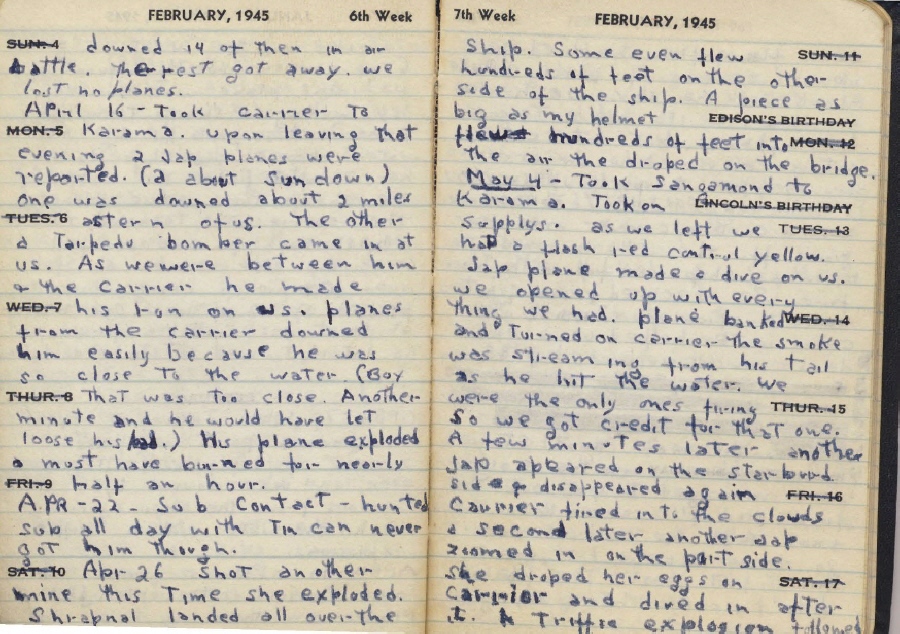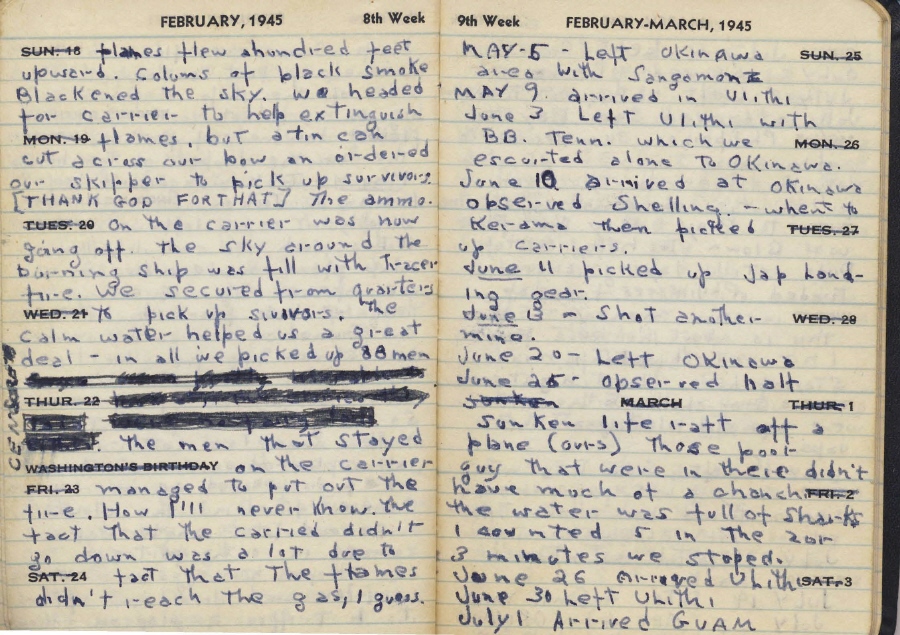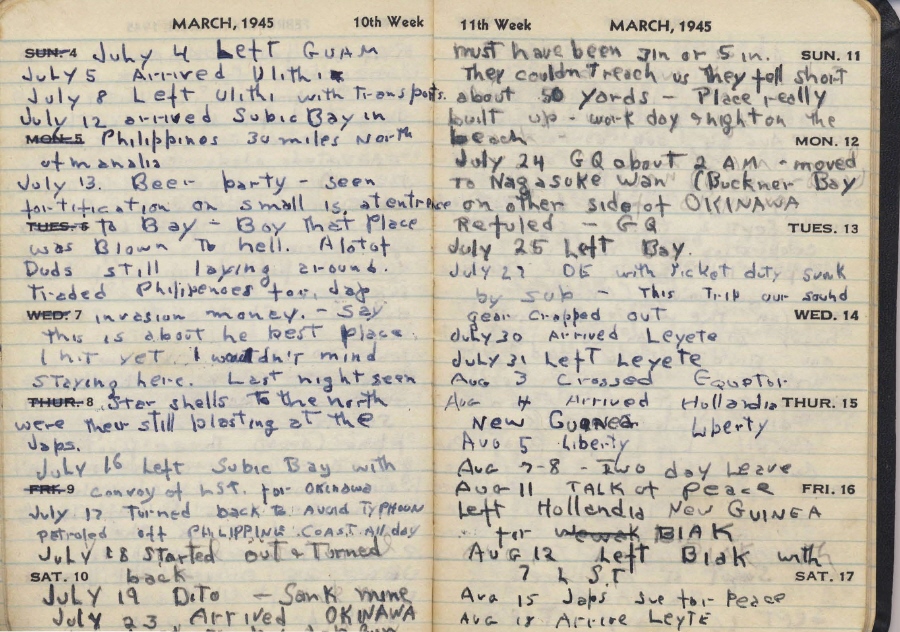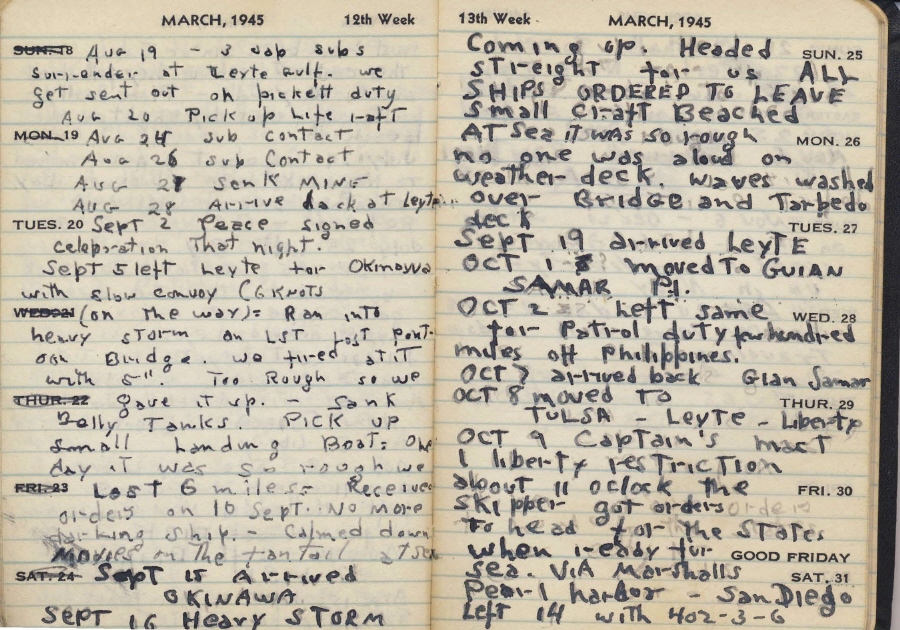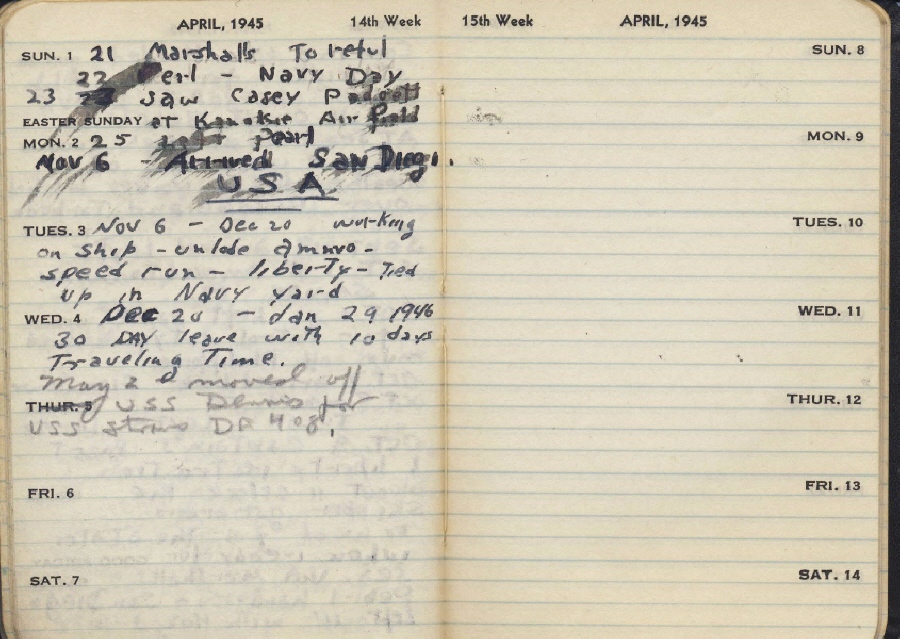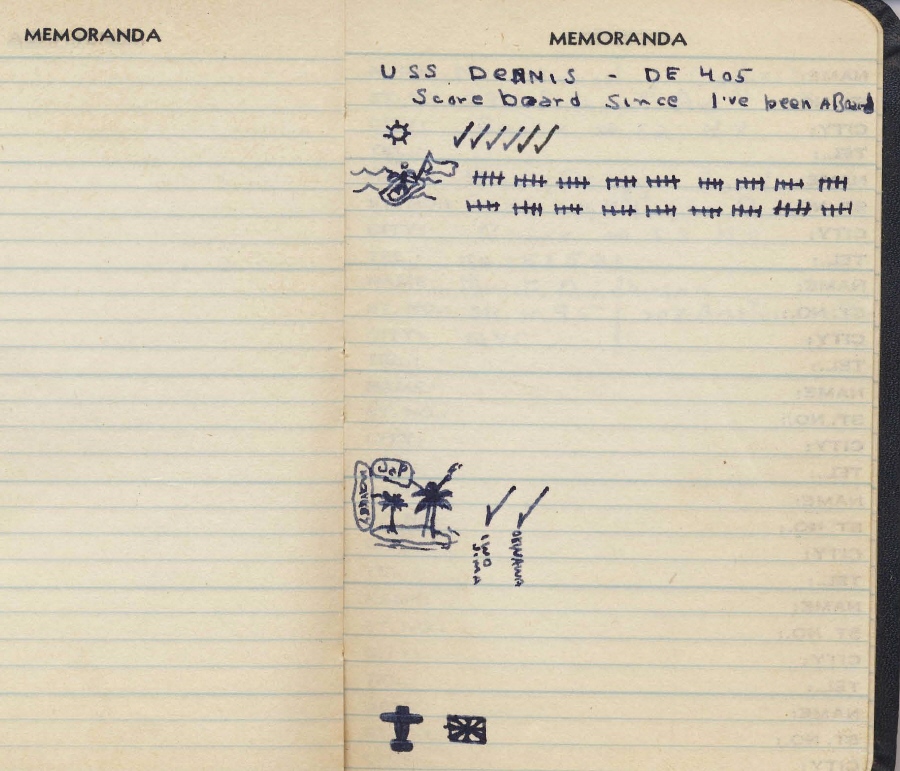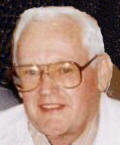|
U.S.S. Dennis
D.E. 405
Log Book
Historic Summary
Diary of Edward Cafferty
F1C – USNR
1944-1946
Note –
Notes from the ships log of U.S.S. Dennis are written in blue
Notes from the diary of Edward Cafferty F-1C are written in green
20th March 1944
Ship Commissioned at Houston, Texas
20th March – 7th April 1944
Fitting out at Houston & Galveston, Texas
7th – 13th April 1944
Enroute to shakedown area Bermuda, BWI
13th April – 10th May 1944
Shakedown training Bermuda area
10th – 12th May 1944
Enroute Bermuda to Boston, Mass.
12th – 20th May 1944
Post shakedown availability at Navy Yard, Boston, Mass.
29th May 1944
Passage through Panama Canal
30th May – 6th June 1944
Enroute Balboa Canal Zone to San Diego, Calif.
6th – 13th June 1944
Availability for voyage & other repairs at destroyer base San Diego
14th June 1944
I was sworn in – USNR
17th June 1944
My 18th birthday
19th – 23rd June 1944
Final exams 4th year High School of Commerce
N.Y.C (History exam. Fri. 6/23/44 9 a.m. to 12 noon)
23rd June 1944
Left home for active duty (8 p.m.)
13th – 19th June 1944
Enroute to Pearl Harbor, Hawaii to Eniwetok,
Marshall Islands as screen commander for
Convoy #4219A. The trip was made by way of
Majuro & Kwajelein and ships were detached
from convoy at both of these ports.
24th June – 5th Sept. 1944
Boot Camp – Samson N.Y.
5th – 12th Sept. 1944
On leave at home
4th – 5th July 1944
Enroute Eniwetok to Kwajelein proceeding independently
5th – 13th July 1944
Enroute Kwajelein to Pearl Harbor as part of
Escort for Convoy Kwajelein Pearl #1
13th – 22nd July 1944
Availability & voyage repairs at Pearl Harbor
22nd – 29th July 1944
Enroute Pearl Harbor to Kniwetok as escort to
U.S.S. Belleau Wood CVL -24
29th July – 2nd Aug. 1944
Enroute Eniwetok to a rendezvous position
east of Guam, as escort for U.S.S. Belleau Wood CVL-24
1st August 1944
Recovered 3 man crew of crashed Belleau Wood plane
2nd – 4th August 1944
Enroute from rendezvous point to Eniwetok
4th – 9th August 1944
Repair & upkeep at Eniwetok
9th – 13th August 1944
Enroute from Eniwetok to Manus Island,
Admiralty Islands to commander of screen
12th – 21st Sept. 1944
OGU (Outgoing Unit) Samson, N.Y.
22nd Sept. 1944
Arrived Great Lakes Naval Training Center, Ill.
25th Sept. – 9th Nov. 1944
Attended Basis Engineering School. Weekend
liberty in Chicago, Ill. and Milwaukee, Wisc.
For Carrier Division #22
10th Sept. – 1st Oct. 1944
At sea as part of escort screen for Task Group
77.1 which acted as the support air group for
the invasion of Morotai Island. During this
operation, (the only one in which Escort
Division 63 acted as a unit with Com. Cort Div.
63 as screen commander) no direct enemy
contact was made by this ship, although
several unidentified aircraft were reported
near the formation. No attach was made on
the formation during the time this ship was in
formation. After the ship had been detached
to return to the Admiralty Islands, the U.S.S.
Shelton – DE 407 (one of our sister ships) was
torpedoed & sunk by an enemy submarine.
1st – 12th October 1944
Upkeep & repair at Seeadler Harbor.
12th – 25th October 1944
At sea as part of escort screen for Task Unit
77.4.3, Northern Air Support Group covering
the landings on Leyte Island, Philippines on
October 20th 1944. This ship was attached to
Task Unit 77.4.34, which furnished air support
for the Northern Transport Group enroute to
the objective area. On 20th Oct. 1944 Task Unit
77.4.34 was dissolved and the ships in the unit
joined Task Unit 77.4.3. No enemy contact
was made by the ships of this unit until 0650
item on 25th Oct 1944, when an enemy task
force was sighted 15 miles from the unit,
between our ships & Samar Island. As the
faster enemy task group composed of 4
battleships, 8 cruisers & 12 destroyers closed
our formation destroyers & destroyer escorts
of our screen interposed to the westward
between the enemy & our own carriers. This
ship opened fire on the enemy formation at
0740 & continued fire throughout the
engagement with main batteries. A torpedo
attack was made on an enemy cruiser, firing 3
torpedoes at a range of 8000 yards. On
completion of the torpedo run, this ship was
ordered to lay a smoke screen between the
carriers & the enemy. While interposing
between our carrier group & the enemy
cruiser, this ship was hit 4 times, 3 direct hits
from 6 or 8 inch enemy guns firing armor
piercing shells & one hit from shrapnel. All
damage was brought under control & when
the enemy retired to the north, this ship
rejoined the carrier group. When the U.S.S.
Saint-Lo CVE 63 was hit & subsequently sunk,
this ship effected the rescue of 434 survivors
from the sunken carrier. The personnel losses
suffered were 5 men killed in action & 12 men
wounded in action. The Commanding Officer
Lt. Comm. Hansen was awarded the Navy
Cross for his heroism during the engagement.
While enroute to Kossol Passage, our 5 dead
and one of the rescued survivors, which died
overnight, were buried at sea. Shortly after
the burial ceremonies were complete,
torpedoes were sighted coming in our direction,
and a rapid port turn saved this ship from total
disaster as two torpedoes traveled alongside
on starboard, within 50 feet of this ship.
25th – 27th October 1944
Enroute to Kossol Passage where survivors A&
hospital cases were discharged. Passed
through enemy mine field enroute.
27th – 31st Oct. 1944
Anchored in Kossol Passage. Upkeep & repairs.
10th – 13th Nov. 1944
66 hrs. liberty
21st Nov. 1944
On draft (as fireman 2nd class)
31st Oct. – 3rd Nov 1944
Enroute to Manus Is. Admiralty Islands.
3rd – 7th November 1944
Upkeep & repairs – Manus Island.
7th – 18th November 1944
Enroute Manus Island to Pearl Harbor, T.H. as
part of screen for CAR-Div 25.
22nd – 25th Nov. 1944
On troop train enroute Chicago, Ill. to
Shoemaker Calif. On train for Thanksgiving
day. Waiter said “1st turkey dinner is on Uncle
Sam. If you want a 2nd one you’ll have to pay
for it.” 3 of us had 2 dinners.
27th November 1944
I passed physical for overseas duty.
20th – 26th November 1944
Enroute Pearl Harbor, T.H. to San Francisco,
Calif., as escort for merchant ship.
26th Nov. – 22 Dec. 1944
Availability & repair San Francisco, Calif.
1st December 1944
I boarded the U.S.S. Dennis – DE 405 at
Alameda Shipyard, Alameda, Calif. Welding
going on all over the ship repairing damage
from sea battle. Crew very nervous. Talked
about the battle. I was assigned a battle
station on gun 42 as second loader. Gun 42
was being changed from twin 40 mm to quad
40 mm. I found that the man I replaced was a
colored fireman who was killed in the sea
battle. He was decapitated by shrapnel. While
the ship was in the U.S.A. 23 of the crew went
(AWOL) over the hill.
12th December 1944
Left Alameda for Mare Is. – Loaded Ammo. –
Then to Treasure Island.
1st – 22nd December 1944
While in California had liberty in Oakland and
San Francisco. George “Red” Geisen from
Buffalo, N.Y. & Al “Cisco” Cofrancisco from
Deep River, Conn. & I went through Great
Lakes Basic Engineering School together. We
came west on the same troop train to
Shoemaker, California. From there we were
assigned to the U.S.S. Dennis, Red to the
forward fireroom, me to the aft fireroom &
Cisco to the aft engine room. We went on
liberty together to San Francisco, & we bought
a pint of what the sailors called Chinese
whiskey – chen-lee. I drank my 1/3 of the
bottle in one gulp. That was my first taste of
whiskey. You might say we took Cisco to
Frisco to sow some wild oats before we went to war.
21st December 1944
Last day in the states before going overseas.
Order of the day – no one is to leave the ship.
Don’t set foot on the dock. Marine guards on
the dock with submachine guns to enforce the
order. Movie on the fan tail that night.
22nd – 28th December 1944
Enroute San Francisco, Calif. To Pearl Harbor,
T.H. Steaming independently. I was seasick all
the way. (It started shortly after we lost sight
of Golden Gate Bridge over the horizon)
25th December 1944
Christmas at sea. Captain Hansen awarded
purple heart medals to the men who were
wounded in previous engagement with the enemy.
1st January 1945
My 1st liberty in Hawaii – Honalulu & Wikiki.
Dec. 1944 – March 1945
I was assigned to the mess hall.
28th Dec. 1944 – 12th Jan. 1945
Upkeep & training at Pearl Harbor, T.H.
12th January 1945
Left Pearl Harbor
12th – 18th Jan. 1945
At sea conducting rehearsal exercises with
Task Force 51 as part of screen of Transport
Group Able. I was seasick this week too.
13th January 1945
Arrived off Molokai Hawaiian Is. Patrolled off
coast for mock invasion.
17th January 1945
Left Molokai with convoy
18th January 945
Arrived beach at Oahu
18th – 24th January 1945
Upkeep & training at Pearl Harbor, T.H.
24th January 1945
Left Hawaii with convoy. The sea was calm & I
didn’t get seasick. I must have found my sea
legs – I wasn’t seasick anymore after this.
30th January 1945
Crossed International Date Line. 180o
longitude. Initiated
6th February 1945
Arrived Eniwetok Marshall Islands. Low sandy
islands with few palm trees. Most palm trees
were shot off at the trunk. When we came
into the Marshall Islands, I saw more ships
than I ever saw before. There was every type
of ship here. They were anchored as far as you
could see (to the horizon) in every direction as
we sailed through them for 20 minutes to our
anchorage. There must have been hundreds of
ships here.
24th Jan. – 20th Feb 1945
At sea with Task Group 51.5 enroute from
Pearl Harbor, T.H. to Iwo Jima. Stops at
Eniwetok & Guam, enroute for fueling &
provisions. The commanding officer
(Commander Hansen) of this ship served as
commander of screen during this operation.
9th – 13th February 1945
Enroute from Eniwetok to Guam. On this trip I
was talking to Mr. Tuck one day as we stood at
the ships rail looking out at the sea. I asked
him if he know where we were going. He said
“we’re going to invade a place called Iwo
Jima”. That was the first time I has ever heard
of the place.
13th – 16th February 1945
Anchored at Guam. A pretty island with
mountains. Went ashore here on loading
details & beer party
16th – 20th February 1945
Left Guam with LST Convoy with marines for
invasion of Iwo Jima. Slow convoy.
Since leaving the states we had tests of G.Q.
(general quarters) alarm every sunrise &
sunset and another test once or twice a day,
with verbal orders over the P.A. system
announcing “testing general alarm – man you
battle stations”. Then the alarm would be
sounded. On the evening of the 18th of Feb. I
was washing mess trays from evening chow, in
the scullery with John Glenn when the G.Q.
alarm went off. We looked at each other for a
split second then I said “They didn’t announce
that they were testing.” I leaped over the split
door with a stack of mess trays on the ledge &
made it to Gun 42 in record time. It’s amazing
how fast you can move when your scared.
Boogies (unidentified aircraft) in vicinity – no
enemy contact – secured from G.Q. – this was
the first of many calls to G.Q. most of which
are forgotten but I’ll always remember the first one.
18th February 1945
Sighted enemy mine. Sank same with small arms fire & 20 mm.
19th February 1945
D-Day – Iwo Jima
20th February 1945
D-Day + 1. At G.Q. this morning, we saw a
volcano island. It rose out of the sea to a
height of a few thousand feet. We are in the
Volcano Islands. This group consists of 3
islands: Iwo Jima the largest, 8 square miles,
highest elevation Mt. Surabachi 546 ft.
Minami the southernmost island has an
elevation of 3021 ft. (this was the island that
we saw that morning). The 3rd & northern
most island is Kita with elevation of 2520 ft.
We arrived at Iwo Jima this date. It’s 70 miles from Tokyo.
Observed shelling of Island. The sky was
heavily overcast all the time we were here.
Everything seemed colorless & gray. I thought
as I watched the island & all the ships this is
just the way it would look in the newsreels in
the movies back home – black, gray & shades of gray.
20th Feb. – 1st March 1945
At sea as part of screen covering the Iwo Jima
operation (Task Group 51.2). During this
period, this ship observed considerable anti-
aircraft firing, but didn’t take any enemy
aircraft under fire. This ship also took part in
hunter killer operations against enemy
submarines with other escorts.
21st February 1945
While I was off duty I was hanging around by
my battle station. This was common practice.
If they came over you didn’t have far to run.
While looking through the lookouts binoculars
at the beach I saw a group of our planes dive
bombing a Jap position. They went in singly
one after the other. I could see the Jap anti
aircraft fire all around them. The third plane in
got hit before he pulled out of his dive & he
went straight down and exploded. I handed
the binoculars back to the lookout and went below.
22nd February 1945
Air raid
23rd February 1945
Went up to hospital. Ship relief, to transfer
gunnersmate who was injured at G.Q. – his
foot was caught in 5” gun mount. Saw the
marines on the beach using flame throwers on
Japs in the caves. That morning I was off duty
& at Fun 42 when the captain announced over
the P.A. system that the U.S. Marines had
raised our flag on top of Mt. Surabachi at 10:38
that morning. We were off the end of the
island on Mt. Surabachi side about 2 miles out.
I looked through the binoculars & could see
our flag clearly.
23rd and 24th Feb. 1945
Air raids
1st March 1945
Detached from Task Group 51.2 & reported to
Task Group 52.2, for duty in escort carrier screen.
1st March 1945
Left our patrol position to escort carriers about 30 miles out.
1 to 9 March 1945
Operating in screen for escort carrier group launching strikes on
Iwo Jima.
2nd March 1945
At 0400 called to G.Q. when I got out on deck it
was pitch black. The sky was heavily overcast
& there was no light from the moon or stars. I
groped for the ladder to the torpedo deck
bumping into a couple of men in the dark.
Once at my station I put my hand up close to
my face & moved it around. I couldn’t see it.
It was so dark it didn’t make any difference if
you had your eyes opened or closed, you
couldn’t see anything anyway. In spite of the
dark, everyone was at his station within a
couple of minutes. This is a good crew. As I
stood at my station there was a sudden
explosion & flash of light on the main deck
below us. Someone said “we’re hit”.
A minute later we felt the friendly vibrations of
depth charge going off. What we saw & heard
was the K guns below firing depth charges at a
sub. We never will know if we hit him or not.
3rd March 1945
While on patrol saw object in the water.
Moved in to investigate. The air was filled
with a sickening smell. It was a body in a life
jacket. We caught it with a grappling hock
from the bow and pulled it up to the deck. It
was the torso in the jacket – no head, no arms
or legs. The executive officer shouted up at
the Captain on the bridge “It has Japanese
writing on it”. The Captain said “Throw that
thing back in and let’s get out of here.” I
watched it float past and wondered, as I guess
the rest of us did, if I might wind up like that
one of these days. As we picked up speed and
moved away from area we were glad to get a breath of fresh air.
9 to 11 March 1945
Enroute to Ulithi Harbor, Western Carolines.
11th March 1945
Nearing the western Caroline Islands. It was
morning and the sea was like a green sheet of
glass. It was that calm and that color. We
sighted a bright colored object on the horizon
as we went towards it, the only ripple on the
water was from our wake. We pulled up
alongside the object that we now saw was a
huge life raft. It was riddled with holes &
submerged except for a foot or two that had
an air pocket and held it afloat. This bubble is
what we first sw. I stood at the rail above the
life raft as we came up to it and stopped. Dow
in the green clear water circling the raft was a
huge white shark. He had to be 20 foot long or
bigger. I figure that’s how long the raft was &
he was just as big. As we lay still in the water
you couldn’t help but get a little nervous –
we’re a sitting duck for a sub right now. Our
sister ship, the U.S.S. Shelton DE407, was
torpedoed by a Jap submarine under less
favorable circumstances (for the sub) and we
see below us in the water what is waiting if we
should be sunk. I looked at the holes in the
raft and wondered about the men we didn’t
save. The Islands of Yap and Truk are in this
group and are still held by the Japanese. If we
have any air raids while in Ulithi the enemy
plans will be coming from them. We were at a
dead stop for 2 or 3 minutes. We started off
slowly and the show wasn’t over yet. As we
moved out a school of large fish, each one
about 3 foot long, started passing under our
ship. They were racing. They kept coming for
about 5 minutes. There were thousands of
them. As the end of the school approached we
could see why they were in a hurry. There
were 8 or 10 sharks each about 5 foot long
chasing the school.
11th March 1945
Arrived Ulithi, in the western Carolines. A
pretty group of tropical island in a green sea,
about 9o above the equator.
11th to 20th March 1945
Carrying out logistics & upkeep, Ulithi.
While at Ulithi we had a couple of beer parties
on Mog Mog Island. You get two or three cans
of beer which go down pretty quick in this
heat. A lot of heavy gambling goes on. It’s
nice to set foot on dry land again but after a
few hours in the heat it’s good to be going
back out to the ship where there’s a breeze.
On one trip ashore I took a long walk on the
beach away from everyone. I saw a native
fisherman in an outrigger. We waved to each
other. I walked further & came across a
wrecked landing barge about 30 yards out. I
stripped down and swam out to it. It was nice
on the barge. Very peaceful. The water was
so clear I could see all kinds of fish & coral on
the bottom about 20 feet below. I had a nice
b.a. swim & got a very B-A-D sunburn.
While at Ulithi I saw the prettiest sunset I’ve
ever seen or hope to see again. The red ball of
fire going down into the sea of green splashed
the clouds with the colors of the rainbow.
18th March 1945
Sunday – went to church on Ulithi. The chapel
was a native type structure with a high grass
roof. The posts along the sides supported the
roof. There were no walls.
21st to 25th March 1945
At sea, enroute to Okinawa with Task Group
52.1 as part of escort carrier screen.
21st March 1945
Left Ulithi with carriers
25th March 1945
Arrived Okinawa. D-Day minus 7 days
At sea in assigned carrier strike area near
Okinawa, screen escort carriers of support air
group (Task 5.1.1) for invasion. Sank 2nd mine today.
Note
Julius Tueckhardt
A short stocky fellow in his late 20’s from Brooklyn, N.Y. He was a
little loud at times, but what a pair of eyes. Julie was a seaman
and
did his watch on the bridge, as a lookout.
There was a story around the ship of a time a
boogie (unidentified
aircraft) was reported 50 miles away. Old eagle eye Tueckhardt
raised
his binoculars to his eyes and sounded off “I can see him”. We all
got
a big laugh out of that. But we didn’t laugh the night he was on the
0400 to 0800 watch. There was a moderate sea with a moonlit sky.
He spotted a mine in the water dead ahead of us. We hung around
the area until daylight and sunk it with gunfire.
Thank you Julie and God bless you.
27th March 1945
Was called general quarters 5 times today. (If
this keeps up somebody’s liable to get hurt.)
28th March 1945
Finished my 3 months of mess hall duty.
Started standing watches in aft fire room. My
watch was made up of: falls 3C WT in charge;
Jenkins on evaps; Kornwiski on feedwater
throttle & Cafferty burnerman.
30th March 1945
Our radio picked up an observation plane over
Okinawa. He was directing the shelling by our
battlewagons off at sea. We were in the
mess hall having noon chow when they piped
this over the radio. Today is Good Friday, 3
days before D-Day.
31st March 1945
Detached & ordered to report to Task Unit 5.2.1.2.
Convoys arriving today.
1st April 1945
Easter Sunday – April Fool’s Day and D-Day on
Okinawa. A formation of flying forts flew over
our ship on the way to Okinawa. They were
miles high. We could just about see them. I
never saw planes fly so high before.
1st – 2nd April 1945
Enroute with U.S.S. Saginaw Bay (CVE-82) to
Kerama Retto for logistics. Shortly after arrival
all ships went to battle stations to repel enemy
air attack. At 0859, April 2, 1945, one enemy
aircraft which apparently was making a suicide
run on the Saginaw Bay, was after intense A.A.
fire by ships further out, observed to crash in
water about 50 feet from an LST anchored one
mile away from this ship.
1st – 2nd April 1945
Left southern part of Okinawa for Karama
Retto. (Secured March 26th 1945.) We call this
place ‘Suicide Bay’. A name well earned. For
the past week never a day went by without 30
or 40 jap suicide planes comer over. We were
tied up alongside a landing craft type
ammunition barge taking on ammo, when a
jap came over. I was assigned to the loading
part on the barge. When the G.Q. alarm
sounded we men on the barge were told to say
where we were. I look around. There was
nothing but shells & powder canisters. 5”
shells, 8” shells & I was standing on shells for
battelleships big guns that were bigger than I
was. The plane made a suicide run on our
carrier that was off our starboard side. He
must have overshot his mark because he flew
right over us, and went for an amphibious
ammunition ship on our port side. (I guess it
was an ammo ship – she was flying baker).
(Baker = red flag signal flag for letter B).
There was a lot AA fire & I was told he crashed
into the water near the LST on the other side
of us. We finished loading supplies & left to
join the other carriers the next morning.
Kerama Retto was an atoll type island with
high rocky sides and lots of vegetation. It had
a large lagoon and it provided an anchorage
for a large number of ships. Ships that were
damaged by suicide planes were towed in
here. I saw a large supply ship here that hit a
mine. It took some chunk off the bow.
Another time we saw a tin can that took a
kamakazi hit on the bridge. The deck was
wiped clean right back to the stack. It killed all
the officers except the engineering officer. He
brought the ship in with after steering. This
ship was the U.S.S. Hazelwood DD531. That
Warren Schmitt later served on in Korea in the
50s. (Warren was friend of ours who we met
when moved to Hastings.) Another time at
Kerama Retto, a jap swam out at night from
the island and climbed up the anchor chain of
one of our cruisers. He ran down the deck and
stabbed the O. D. (officer of the day) killing
him. He then dove into the water and swam
to shore. After that when we came in here
overnight, we had a shotgun watch on the bow
and on the fain tail. I took my turn at this watch.
3rd April 1945
Rejoined air support group. Sank floating
mine. Formation attacked by enemy planes,
two of which made suicide dives on U.S.S.
Wake Island (CVE-65) with resultant near miss
damage. During action, two flight deck
crewmen fell overboard in parked Wake Island
plane and were shortly thereafter picked up by
this vessel. This ship did not open fire on
enemy planes which were on foul bearing on
the other side of formation. Ordered to
proceed to Kerama Retto with U.S.S. Wake
Island for her emergency repairs.
While out with carriers, 4 jap planes came
over. Our planes got one. One was shot
down. The other two made unsuccessful
suicide dives on the Wake Island (the carrier
directly in front of us). One plane avoided by
making a sharp turn, but a bomb hit the water
close to the carrier causing her to rupture
below the water line. The sharp turn caused
planes on her deck to turn over and smashed
into each other. One plane fell over the side
with two men. Our ship, being closest, picked
up the 2 men. The second man to be picked up
was on some floating wreckage. At first he
appeared to Japanese. The first lieutenant
stood at the rail with a 45 automatic. We
thought the guy was one of the jap pilots that
crashed. He must have seen the gun and
hollered up “Hey – I’m an Indian – I’m more an
American than you are”. We picked him up.
4th April 1945
Rejoined escort carrier group.
Note: These T.U. consisted of 6 CVE (baby flat
tops) & 7 escort ships (D.E.& D.D.s)
7th April 1945
Left carrier group with 2 carriers and escort to
rendezvous with carriers joining Task Unit
52.1.2. Enemy plane intercepted by cap and
shot down close aboard friendly carrier 3 miles
off this formation.
While taking 2 CVEs to rendezvous point we
passed to CVLs. A jap plane (a betty) came
over and was downed by corsairs from the
other carriers. He hit the water with a terrific explosion.
8th April 1945
Rejoined carrier group. On returning from bombing the
beach, plane from our carriers would sometimes horse
around and dogfight each other in the sky over
our group after a successful mission. One
evening we were called to battle stations.
Before our planes returned from the beach.
Shortly after some of our planes returned in a
playful mood. One made a dive at the radar
atop our mast. Another flew along our
starboard side about 20 feet above the water
and 100 fee off our ship. Our guns were
loaded and trained on them. As the plane flew
past our quad 40 mm. We hollered “Fire!
Fire!” The man on the trigger turned and said
“It’s one of ours”.
Another time we were called to quarters. We
were called to quarters one evening. Guns
were loaded. Boogies were reported at a
distance. The distance increased. They were
after another target. We secured from
quarters. That night I had the 12 to 4 watch.
The next morning, I was sleeping in, when they
announced of the P.A. system that the aft 5”
gun would be unloaded through the muzzle.
My bunk was right next to the lower handing
room of the 5’ fun. I was sound asleep when
they fired. I jumped up. The compartment
was filled with the smell of gun powder and no
one was around. I grabbed my life belt and
took off through 2 compartments in my skivy
shorts and was headed up the ladder to the
main deck when someone hollered “Hey
Cafferty, where are you going?” He told me
what happened and I went back to bed.
9th April 1945
Enroute to Karama Retto with carrier for
replenishment. Took on mail from another DE,
whose captain was Franklin D. Roosevelt, Jr.
10th – 11th April 1945
Logistics in Kerama Retto & rejoined carrier group.
It became common to be called to battle
stations a number of times every day and night
by the G.Q. (General Quarters) alarm bell. It
was about 0400 when I was awakened by the
sound of the bell. I was awakened from a
sound sleep. I pulled myself up, but before
(bunks were 3 high. I had the bottom bunk, by
a compartment door. There was a red battle
lamp by door. It came on when regular lights
were turned off.) I could swing around to get
out of my sack. I could see by the red light of
the battle lantern below my bunk that
everyone was still sleeping. The ship rolled
along and the bunks creeked back and forth. I
could still hear a distant bell ringing in my ear.
I laid back down and as my head hit the pillow,
the G.Q. alarm went off. As I leaped up with
everyone else, I thought to myself “My God!
Now I’m hearing the alarm before it goes off”.
(ESP - ?)
April 12th 1945
President Franklin D. Roosevelt died and
Franklin D. Roosevelt, Jr.’s ship left the group
Planes from our carriers intercepted jap planes
on their way to us and downed 14 of them in
an air battle. The rest got away. We lost no
planes. The Captain announced over the P.A. system.
15th April 1945
Escorting carrier to Kerama Retto for
replenishment. (To pick up mail for our group
& food, ammo & fuel)
16th April 1945
Logistics, upon return from Kerama Retto,
C.A.B (combat air patrol) shot down enemy
plane at dusk, approximately 2 ½ miles away.
Enemy plane burned in water and explosion
felt as from depth charge depth charge detonating.
Took carrier to Kerama Retto. Up leaving
around sundown, a jap plan was spotted. The
planes from the carrier were off bombing
Okinawa. He circled our position on the
horizon. It was a torpedo bomber. The man
on the phones said we got orders from the
carrier to stay between the carrier and his fish.
At the moment we were expendable. As I
stood cuddling my greasy 40 mm clip and
cursing that jap, my life flashed before me. As
he came in for a landing, he circled and went
after the jap. The torpedo bomber was making
his run on us and we were running along side
our carrier protecting her. I was scared. Even
if our plane gets him, if he get that fish off first,
we’ll have to take it if there is any danger to
our carrier. Frank Dibella said to me “Cafferty,
I’m scared.” The big Indian on the other side
of Frank said “Shut up – we’re all scared”. For
a second I felt good. We watched and cursed
as the drama which we were very much a part
of unfolded before us. The jap was about 2 ½
miles from us flying about 10 feet off the
water, over a fairly calm sea as our man made
his strafing run. He got him. We let out a
holler as the jap hit the water burning. He
burned for about 20 minutes before he blew
up. We neared the wreckage in time to see it
sink and a lot of us were still cursing it.
17th April 1945
Rejoined carrier group.
Our radio often picked up Tokyo Rose and we
would hear her on the radio in the mess hall at
chow time. She played all the popular songs of
the time in between little propaganda pitches.
One evening we went to general quarters and
there was a jap plane over the horizon. He
would pick up enough altitude to see us, and
we him, the drop back below the horizon. He
didn’t attack us. I didn’t realize it at the time
but this was an observation plane counting the
ships in our group. The next day Tokyo Rose,
in reporting the news, stated that the Imperial
Japanese Air Force attached our group giving
our location and number and types of ships
and said the Imperial Japanese Air Force sank
us all. I guess this was just their way of letting
us know that they know where we were at.
Hell, we know that they know where we were.
They visited us often enough. In another
propaganda pitch, Tokyo Rose told us that
there were 13,000,000 men in the U.S. Armed
Forces. Of these a million were
overseas, and of these so many hundred
thousands were involved in actual combat.
Suckers! Wouldn’t you like to go home?
22nd April 1945
Made three hedgehog attacks on underwater
sound contact originally picked up by adjacent
escort. Negative results. Assisted other escort
in carrying out retiring search plan for nine
hours on contact with negative results. Rejoined formation.
Sub contact – Hunted sub all day with tin
can –
never got him though.
23rd April 1945
Proceeding to Kerama Retto with carrier.
24th – 25th April 1945
Logistics in Kerama Retto. Rejoined group.
26th April 1945
Left group with carrier on special duty.
Exploded horned type contact mine.
Sighted another mine, started shooting at
same with 20 mm guns and small arms fire.
She was off our starboard side in a sea of
heavy swells. As we fired at the mine, our ship
drifted in closer. Then it exploded. Shrapnel
landed all over the ship. Some even flew over
our ship and landed hundreds of feet off our
port side. A piece as big as my helmet flew
hundreds of feet into the air and dropped on
the bridge. When the mine was sighted, I was
watching from the forward 40 mm gun mount
near the bridge. When it exploded there was a
white cloud of smoke as high as a five story
building. I dove under the twin 40 mm, and
looked up to see this chunk of shrapnel drop
on the bridge.
27th April 1945
Rendezvoused with joining carrier. Rejoined
air strike group.
29th – 30th April – 1st May ‘45
Task Unit 52.1.2 dissolved and absorbed into
52.1.1. Detached from Task Unit 52.1.1 and
joined Task Unit 52.1.3. Detached on
independent duty to rendezvous with Task
Group 50.8 to transfer pilots for replacement planes.
2nd May 1945
Rejoined carrier formation.
3rd May 1945
Enroute Kerama Retto with carrier U.S.S.
Sangamon – CVE-26 for logistics.
4th May 1945
Logistics in Kerama Retto. Upon departure,
the formation, composed of U.S.S. Sangamon –
CVE-w6, U.S.S. Fullam – DD474 and this ship
was attacked by enemy planes. This ship was
first to open fire and fired continuously
throughout the approach of the first plane
which missed the carrier by a matter of feet in
a suicide dive. Thereafter, the carrier and
destroyer commenced fire on two enemy
aircraft. One plane crashed on the carrier’s
flight deck resulting in a serious fire and severe
accompanying explosions. The Fullam later
reported destroying the plan which they had
under fire. This ship, together with the Fullam,
was proceeding to the aid of the stricken
carrier, but was ordered to stand clear and
pick up survivors. The carrier was saved after
an hour and a half only by the superb damage
control and fire fighting of it own personnel,
personnel of the Fullam and another destroyer
which came out of Kerama Retto to assist. In
the meantime, this ship picked up 68 survivors
in the darkness and its motor whaleboat
reported delivering an additional 20 to rescue
vessels which had come out from Kerama
Retto to assist. The ship also received credit
for the destruction of the first suicide plan
which was also fired upon by the Sangamon.
(Commander Hansen – our captain received
the bronze star for this action)
Note: On rereading this I want to add this
note. While in the war zone there were two
things that a ship should never do:
1.) Never stop dead in the water
2.) Never show a light at night. No smoking
allowed on deck after dark.
In picking up men from the U.S.S. Sangamon
the U.S.S. Dennis stopped dead in the water
and turned on its searchlights to aid in picking up 88 men.
Took Sangamon – CVE 26 to Kerama Retto.
Took on supplies. As we left in late afternoon
before sunset, we had report of boogies at 60
miles and closing. Each succeeding report
brought them closer. At flash red condition
yellow, we were called to battle stations.
Shortly later they arrived. The sky had patches
of low clouds. Te first one came diving out of
the clouds and there we were dead ahead of
him on a 45o angle. The carrier was astern of
us and to starboard less than half a mile away.
I looked up and saw him and it looked to me as
if he was making his dive right at me. We
started firing and didn’t stop until 40 mm
ammo racks were empty. The plane banked
and went for carrier. We must of hit him. The
smoke was streaming from his tail when he
crashed into the water right along side the
carrier. A few minutes later another jap
appeared on starboard side and then
disappeared into the clouds again. The carrier
fired into the clouds. A second later a jap
plane dropped out of the clouds, went straight
for the carrier. I saw him drop his bomb on the
flight deck and go right in after it. A terrific
explosion followed. Flames flew a hundred
feet upwards. Columns of black smoke
blackened the sky. It all happened so fast. Our
guns couldn’t fire at the second plane without
hitting the carrier. Gun 42’s ammo racks were
empty from the first plane, and we were
having more ammos passed up from down
below. We headed for the carrier to help
extinguish the flames. A tin can cut across our
bow and ordered our skipper to pick up
survivors. (Thank God for that.) The ammo on
the carrier was now going off. The sky around
the burning ship was filled with tracer fire.
The next day when we saw that can, we could
see where she was hit by exploding ammo and
we heard some of her men were injured. We
secured from quarters to pick up survivors.
The calm water helped a great deal. In all we
picked up 88 men. When it got dark, we
turned on our search lights to find them. I
helped one fellow aboard whose face was very
badly burned, I’ll never forget him. I brought
him below to doc. Another survivor praised
the output of our quad 40. He said he never
saw so much ammo thrown up so quickly. I
told him I was passing ammo on that gun and
we moved it as fast as we could. In the
darkness you could see the little lights from
the flash lights on their life preservers and
hear their whistles in the sea all around us.
We worked at picking up survivors until there
were no more to be found. The men
remaining on the carrier put out the fire. I’ll
never know how.
5th May 1945
Rejoined carrier group. Detached with
Sangamon which was proceeding for
emergency repairs to Ulithi. (Western
Carolines) During the Okinawa operations,
there were numerous air alerts, but due to the
sterling work of the C.A.P., only one group of
enemy planes made contact with the carrier
groups in company with this ship. This contact
resulted only near miss damage to one carrier.
(the Wake Island.)
Our main contacts with the enemy came when
we were detached with one carrier enroute to
or returning from, or at Keramam Retto. We
went in average once a week.
Left Okinawa area on May 5, 145 with the
Sangamon CVE 26.
May 30th 1945
Additional recollections from notes I recently
came across Ulithi memorial day. Tied up along side
merchant ship carrying ammo. Holiday –
Merchant seamen don’t work – had to go over
and load ammo ourselves.
Mass on troopship before invasion – general
absolution – no fasting. Remember the
incident but not the date or what invasion it proceeded.
9th – 18th May 1945
Logistics and routine upkeep in Ulithi.
19th – 26th May 1945
On early warning radar picket station, south of
Ulithi, Western Carolines.
26th – 28th May 1945
Ulithi Harbor – logistics.
While enroute conducted firing exercises and
other drills. Our 5” shot down one of their
drones and was complimented on their
marksmanship by the battlewagon’s skipper.
6th – 8th June 1945
Conducted unsuccessful search for two of
U.S.S. Tennessee’s reconnaissance planes.
8th – 10th June 1945
Enroute to Okinawa.
10th June 1945
Anchored in Okinawa. Enroute to join Taks Unit 32.1.1.
Arrived at Okinawa. Observed shelling. Went
to Kerama Retto then picked up carrier.
11th June 1945
Rejoined escort carrier air strike group.
Sighted object in water. Picked up same. Was
landing gear off jap plane. Tire held it afloat.
There was Japanese writing on tire.
13th June 1945
Sank another mine with 20 mm and small arms fire.
16th June 1945
Enroute to Kerama Retto for carrier replenishment.
17th June 1945
Lieutenant Commander Stanley N. Gleis, USNR
relieved Commander Sigurd Hansen, USNR as
commanding officer during replenishment stay
at Kerama Retto. Steaming to rejoin carrier group.
Had change of command ceremony at Kerama
Retto. Today is my 19th birthdeay.
18th – 26th June 1945
At sea with escort carrier group. Detached 22
June to proceed to Ulithi.
Note:
Sailors who served on destroyers (designated
DDs) also called cans or tin cans, destroyer
escorts (Des) and smaller ships were said to be
in the dungaree navy.
On larger ships the men would have to wear
what was call the uniform of the day. On our
ship, men were allowed to wear whatever part
of the dungaree uniform that was appropriate
for weather conditions. In the southern
latitudes, this would usually mean shoes &
shorts. The white uniform was only called for
on special occasions.
A few years ago, around 1995 while at a
reunion, a number of my shipmates were
sitting around chatting. Frank Tyrrell who has
served as first Lt. raised the question – does
anyone remember when Capt. Hansen retired
and Capt. Gleis took command? I said I can tell
you. It was June 17th 1945. They were all
amazed & said how did you remember that. I
said it was my 19th birthday. We were all
dressed in our whites for the occasion. As we
stood at attention for inspection, I remember
smiling and thinking to myself, “Isn’t it nice
everyone’s dressed up for my birthday.”
Captain Hansen was a tug boat captain before
the war & was probably retired for age.
26th – 30th June 1945
Logistics and maintenance in Ulithi.
30th June 1945
Enroute to Guam with mail and passengers.
1st – 4th July 1945
Logistics in Guam. Received orders to report
to commander Philippine sea frontier.
4th – 5th July 1945
Enroute to Ulithi
5th – 8th July 1945
Anchored in Ulitthi
8th – 12th July 1945
Enroute to Subic Bay, Philippine Islands in
company with U.S.S. Eastland (APA-163) &
U.S.S. Eastland, U.S.S. R.W. Herdon (AD-
121)and other escorts.
Rudyard Kipling wrote of “The Road to
Mandalay Where the Flying Fish Play.” While
sailing through the San Bernardino Straights,
we saw the flying fish at play, and in the
morning we would find a number of them on
our decks. At times schools of porpoise would
race our ship. While going through these
straights, we saw a volcano in the distance
with a column of smoke rising from it. While
at sea, a number of times we saw water
spouts, sometimes two or three together. We
would just alter course and sail around them.
July 12th 1945
Arrived at Subic Bay, Philippine Islands, with troop ships.
That night while in port, we saw a movie on
the fantail. While the movie was on we could
hear the gunfire in the mountains around us
and see the light from exploding shells.
12th – 16th July 1945
Availability in Subic Bay, P.I.
While in Subic Bay, we would often see
Lightsey, Signalman 1C signal to his brother
who was a signal man on a cruiser that
happened to be in port at that time.
Now Lightsey was a man who if you ever
served with him you would never forget him.
First, his name. Not one you hear very often, if
at all. Second, his home. He came from
Okeechobee, Florida. Third, his appearance.
He had red hair, a full red beard and a big
barrel chest covered with curly red hair. He
would have been perfectly cast as a pirate in one
of Errol Flynn’s swashbuckler movies. On a
D.E. with a crew of 200 that you live with all
day every day it doesn’t take long to get to
know everyone, his name, where he’s from,
what he did in civilian life, etc. etc. etc. The
day the japs surrendered, I passed Lightsey on
the main deck and did a double take. He had
shaved off his beard. It was like we had taken
on a new crew member over night. A
shipmate told me he had been in from the
beginning and said he wasn’t going to shave
until the war was over.
Sad Footnote:
After the war I knocked around with different
jobs. I finally settled down working in power
plants, doing the job I learned in the Navy. I
was working for N.Y.C. Dept. of Correction. A
number of Navy vets who were correction
officer were joining the Navy reserves. It
looked like a good deal at the time. In 1949, I
joined the inactive Navy reserves. In June
1950, the North Koreans invaded the South.
Harry Truman called up the reserves. In Sept.
1950, I got my notice. In Oct. 1950, I was in
Port Lyaute in French Morocco, North Africa in
a C.B. detachment. One day while standing on
the chow line, a cook walked by with the name
Lightsey on the4 back of his T-shirt. A fellow
from my outfit that was standing next to me
knew him. I asked him if he came from Florida.
He said he did. I said I have to talk with him.
When inside, I got ahold of the cook and said
“I see your name is Lightsey. Do you happen
to come from Florida?” He said yes, but how
did you know that. I said “Did you happen to
have a relative on the 405?” He said yes that
would have been my brother, Big Red. I said
“How is he?” He said he’s dead. After he got
out he was to be married. He was at a
bachelor’s party with a bit of drinking. He
smashed up his car on the way home and was
killed. He went all through the war only to be
killed in an auto accident afterwards.
Second footnote:
At one of our reunions, one of our
shipmates, John Hindes, who stayed in the
Navy found himself in South Florida after the
war. He thought he would look up Lightsey.
He stopped at a gas station in the Okeechobee
area and said I’m looking for a fellow named
Lightsey. The attendant told him everybody
around here is named Lightsey.
P.S. The cook from Port Lyaute was the signal
man from Subic Bay, P.I. He had stayed in the
Navy & had changed his rate to cooking.
16th – 23rd July 1945
Enroute to Okinawa as escort for T.U. 72.10.3
(13 LSTs and crash boats). Due to bad
weather, convoy was diverted and delayed
and crash boats detached. Convoy proceeded to Okinawa.
This was one of three typhoons that we rode
out. On one, we headed into the storm and at
the end of the day we were 6 miles behind
where we started. The next day, we broke
even and would up the day where we started.
23rd – 25th July 1945
Logistics in Hagushi Anchorage and Buckner
Bay, Okinawa
25th – 30th July 1945
Enroute with Okinawa – Leyte Convoy #7
Enroute to the Philippines, we were lead ship
in the convoy. One night we picked up a sub
contact. We attacked, dropping depth
charges. When these explode, they shake the
whole ship. After a number of attacks, the
vibration damaged our sound gear which
protrudes from the bottom of our ship.
Unable to track the sub any longer, we were
assigned a position on the port side of the
convoy. The next night we heard the
explosion when the ship that took our place
was torpedoed.
30th – 31st July 1945
Logistics San Pedro Bay, Leyte Gulf, P.I.
We were anchored in Leyte Gulf between
Leyte & Samar Islands. A beach party had
been arranged for our crew to play a softball
game with local C.B.s. Red and I were in the
party of about 60 of our crew who were
landed on a small beach. We were not that
interested in baseball & decided to see what
we could see of the island. As the crew
marched along the beach to a street that ran
down to the water, Red and I fell back to the
end of the column. At the street, our column
made a left turn & walked about 2 blocks to
the main road. There they made a left turn to
head for the ball field. Red & I made a right
turn & walked on to see what we could see.
We saw some native huts as we walked along.
We walked a little further & a command car
pulled up along side of us. The officer at the
wheel said “You fellows want a lift?” We
jumped in. As we drove off he said, “I’m going
as far as Provost Marshal’s office. Where are
you going?” At that we became a little
worried. Not know how far that was or what
was ahead, I took a chance and said “Oh, we’re
going a little past that.” We must have gone a
mile or two when we came to his turn off. He
stopped to let us off & we walked into
Tacloban. We saw a big old Spanish church &
some of the local housing. We decided to
head back as it was getting late & we had
come a good ways. On the way back, we saw 2
soldiers with submachine guns guarding a
bunch of jap P.O.W.s. When we finally got
back to the beach, it was late and the beach
was deserted. We were all alone & our ship
was a long way off. After a while, we spotted
a motor whaleboat heading our way. It landed
& we asked if we could get a ride back to our
ship. They were off an Australian Corvet that
was anchored not too far from the Dennis.
They had come in to pick up their mail & were
very obliging. As we neared the Dennis, I
suggested that there was a ladder hanging off
the fantail & they could drop us off there. I
was hoping we could be back on board
without being spotted (not realizing that the
men were counted leaving they ship & again
on returning. The O.D. was 2 men short.) I
started up the ladder. When I came to the top,
I saw a pair of Khaki pants legs. Red was on
the ladder below me & hollering for me to
move up. I was telling him to be quiet, that I
was caught, but maybe they didn’t see him.
We were held for Captain’s mast the next day.
We were found guilty of being AWOL. The
sentence was to be confined to the ship for the
rest of the time we were in port. The ship
sailed the next day.
31st July – 4th Aug. 1945
Enroute independently to Hollandia, New Guinea
On this trip, we crossed the equator on the
3rd
of Aug. 1945 at latitude 00000 & longitude
137o 45’ E. I was initiated into the trusty order
of the shellbacks. On 4th Aug. 945 we arrived
at Hollandia, New Guinea for R&R for the
crew. We all had 3 – 4 days ashore with no duties.
4th – 11th Aug. 1945
Availability, rest and recreation in Hollandia.
The local natives here were head hunters. The
chief of the local tribe had a collection of Japanese heads.
11th – 12th Aug. 1945
Enroute to Biak Island, Dutch New Guinea.
12th – 13th Aug. 1945
Anchored Sorido Lagoon, Biak.
While at Biak the natives would row out to our
ship in their outriggers to trade beautiful sea
shells for cigarettes. (Cigarettes sold at ship
store for 5 cents a pack.) Shortly after this a
number of the crew (this sailor included) came
down with what was called ‘jungle rot’,
circular scabs about the size of a dime all over
your body that itched like crazy. Doc (our
pharmacist mate) (Carlton Antoine Phm 1/C.
He received meritorious advancement for
work with wounded after sea battle.) treated
this with a red solution that he painted on us.
It burnt like hell, but it did the job of clearing it up.
13th – 18th Aug. 1945
Enroute Leyte, Philippine Islands as sole escort
for T.U. 76.14.22 (seven LSTs)
These LSTs were being brought up to the P.I. in
preparation for the next invasion – Japan.
While at sea, we received word of the
dropping of the A-bomb. It looks like the war
may be over soon. This is the happiest day of
my life. It looks like we’ll make it through the war.
15th Aug. 1945
Received word at sea of unconditional
surrender of Japan.
The Captain signaled the convoy that we had a
sub contact. We dropped back a couple of
miles and 2 cans of beer were passed out to all
hands. That was the best can of beer I ever
had. Not that it was a great beer, but for the
celebration that it represented. After a short
period of time the captain announced, “All
right men, throw the cans over the side. We
have to get back to work.” We rejoined the
convoy and sailed happily on the Leyte Gulf.
18th – 19th Aug. 1945
Logistic in Leyte Gulf, Philippine Island.
That night in port observed firework
celebration as the ships all fired off their star
shells. I’ve seen more impressive fireworks
since, but none of them could equal what that
celebration that night in Leyte Gulf meant to me.
19th – 28th Aug. 1945
Patrolling sea lanes off Leyte Gulf, P.I.
28th Aug – 5th Sept. 1945
Tender availability, San Pedro Bay, Leyte, P.I.
5th – 15th Sept. 1945
At sea, Leyte, P.I. to Okinawa.
15th – 16th Sept. 1945
Logistics in Buckner Bay, Okinawa. Harbor
Typhoon plan in effect.
Arrived Okinawa last night. When I woke up in
the morning, our ship was pitching & rolling
heavily. I thought we must have gone back to
sea. When I went up on deck, I saw that we
were still anchored in port. We were told that
a bid typhoon was coming our way and that
we were going back out to sea to ride it out.
16th Sept. 1945
Typhoon plan executed. Proceeded
immediately south and west of Okinawa to
ride out the storm. The ship rode very well
and received minor damage, though center of
storm with winds of 175 MPH approached to
within 100 miles. During the height of the
storm, this ship made several rolls of more
than 50 degrees. A number of smaller ships
were washed ashore and some were sunk.
Coming up the ladder from the mess hall there
is a door on the port side that opens to a
sheltered area on the main deck. A few of us
opened this door to see what it looked like
outside. The sea was wild and the waves were
tremendous. We saw an APA off our port side.
The bow was coming out of the water to
midship by the stack. Then the bow would
plow back into the water and rear of the ship
would rise out of the water to midship with its
screws spinning in the air. It just kept see-
sawing back and forth like that. That ship was
about twice our size. We said if that ship is
doing that what are we doing? We closed the
door and dogged it. We were doing much the
same because the whole ship would shake
when the rear of the ship cam out of the water
and the twin screws would spin in the air It
was quite a ride and we were all glad when it was over
Additional note:
In Jan. 1946 issue of Reader’s Digest, Lt.
Commander Robert Esson Rew, Captain of the
U.S.S. Beagle, a large armed supply ship of
14,000 tons with 29’ draft wrote of his ship’s
experience in the “Typhoon off Okinawa” Sept
16-17, 1945. “The waves were giants 60 to 80 feet high.”
“Ships all around calling for help when there
wasn’t any help and there couldn’t be until the
storm ended.” “I am adrift, out of control;
estimate my position to be…” “I am on the
rocks and breaking up, am abandoning ship.”
“Please send assistance if at all possible.” “ It
was pitiful. Mostly these were little ships –
minesweepers and such. It is
incomprehensible to me how any of them survived.”
17th – 19th Sept 1945
Continued independently to Leyte, P.I. Sank
horned mine by gun fire enroute.
19th – 30th Sept. 1945
Logistics and upkeep in San Pedro Bay, Tolso
Anchorage, Samar, P.I.
14th – 25th Oct. 1945
Returned to Pearl Harbor with the remains of
D.E. Division 63.
Note:
D.E. Division 63 consisted of:
D.E. 402 Richard S. Bull
D.E. 403 Richard M. Rowell
D.E. 404 Eversole (Sunk)
D.E. 405 Dennis
D.E. 406 Edmonds
D.E. 407 Shelton (Sunk)
The 401 Holder and 413 Sammuel B. Roberts
were also sunk.
On the way to Pearl, the Captain made an
announcement over the P.A. system. He said
our ship has been awarded the presidential
unit citation. The citation read: The 63rd D.E.
Division was the most outstanding division in
the Pacific area and the Dennis was the most
outstanding ship in our division. This made me
very proud of my ship, but I realized that the
award was mainly for action before I was a
member of the crew. She was credited with
assisting the sinking of the Japanese cruiser
along with bombs from one of our planes.
I would like to dedicate this book to 5 men I
never knew. They were killed 25th Oct. 1944 in
battle with a larger Japanese task force that consisted of:
4 battleships
8 cruisers
12 destroyers
The American task unit Taffy 3 consisted of:
6 escort carriers – 2 sunk
3 destroyers – 2 sunk
4 destroyer escorts – 1 sunk
In memory of Dennis crew men K.I.A Oct. 25, 1944
George Washington Grater S/1C
John Andrew Sambo F/1C
William A. Curtis FC/3C
Charles Davis, Jr. F/1C
Maynard W. Emery F/1C
6th Nov. 1945
Arrived San Diego, California, U.S.A.
Home on leave for Christmas 1945 and New
Year’s 1946. Celebrated New Years in Times
Square. Back in San Diego had liberty in L.A.,
San Bernardino, San Diego and Tijuana,
Mexico. Worked on decommissioning ship
until end of May, 1946. Was discharged from
the Navy 7th June 1946 (10 days before my 20th birthday.)
More about the U.S.S. Dennis DE405. She was named in Honor of
radio man Otis Lee Dennis. He stayed in his downed airplane,
radioing his position during fall, which made it possible to rescue
the
pilot, at the cost of his own life.
The ship was launched 4th Dec. 1943 sponsored by
Mrs. J.L. Dennis,
Mother of Otis L. Dennis.
Otis Lee Dennis, Born 25th March 1913 in
Scottsville, Ky. Enlisted in
Navy 25th Oct. 1940. Radioman 3rd Class was killed in action Feb. 1,
1942 in attack on Kwajalein in the Marshall Is. Group.
U.S.S. Dennis DE405 was a Butler Class DE
General Information
Overall Length 306’
Length at waterline 300’
Beam 36’ 10’’
Max Speed 24 knots
Displacement 1,600 tons
Complement 14 officers, 201 men
Armor Plate – 3/8’ steel armament
2 5’/38 cal. Guns – main battery
1 twin 40 mm gun
1 quad 40 mm gun
1 triple torpedo tube
10 – 20 mm guns
1 hedgehog rack
2 depth charge tracks
8 ‘K’ gun depth charge projector
Miscellaneous Summary
Total miles steamed from 20 March 1944 to Oct. 1945 – 104,923 miles
Number of survivors rescued – 526
Took part in 4 invasions and 1 sea battle
Mines destroyed – 12
Longest period at sea – 49 days (at Okinawa including days spent in
Karama Retto)
Number of days underway – 350 days (approximately 63%)
Credited with assisted sinking of Japanese cruiser
Credited with downing Japanese plane at Okinawa
Awards
Captain awarded Navy Cross and Bronze Star
Ship awarded Presidential Unit Citation
Crew earned
17 Purple Hearts (5 posthumously)
Navy Combat Action Ribbon
Asiatic Pacific Campaign Medal with 4 Battle Stars
Philippine Liberation Medal with Battle Star
Japanese Occupation Medal
Victory Medal WWII
American Campaign Medal
National Defense Service Medal
Heroes
In my opinion all of the men on the U.S.S. Dennis who fought off a
much larger enemy force at Leyte on Oct. 25, 1944 were heroes.
I would especially like to point out some
individuals. First: the men
below decks in the engine room & fire rooms, who could hear our
guns going off & feel the enemy shells hitting our ship. I’ve been
below when the guns were firing & know that your mind can imagine
all kinds of things when you don’t actually know what’s going on. I
thought myself lucky to be assigned a battle station on the aft 40
mm
gun. There I could see what was going on & know when it was time to
worry & when not.
Lt. John Smyth, a soft spoken gentleman, was
assistant gunnery
officer & during the battle he was in charge of firing the
torpedoes. It
was like a bombardier on a bomber. When the run starts, he is in
charge of the ship. As the O.D. steered the ship on the torpedo run,
enemy shells were splashing in the water around them. He would
steer the ship to the side the last salvo landed. As the japs
corrected
their fire, the next salvo would land where the ship had been. He
played this deadly game until the torpedoes were fired. At 10,000
yards the Captain called Mr. Smyth on the phones & ordered him to
fire. My Smyth replied “We will go down to 7,500 yards or by God we
will go down with the fish in the tubes.”
Later, Lightsey, Signalman 1C, in talking of the
battle aid the jap shells
were flying over our heads on the bridge. I could have reached up &
touched some of them, they came so close.
Leroy Blackburn was Chief Gunners Mate. He was
another soft
spoken gentleman who was well respected & called Blackie by all
hands. During the battle at one point, he was making the rounds of
the gun positions. At the K-guns, he came across Fred Grazino & Bill
Curtis standing together. He told them to break it up & not hang
together. Fred walled off. A few minutes later a shell hit. Fred
turned around, Curtis was gone. Fred lives in Nyack, N.Y. & we
occasionally get together for lunch. Fred told me “Ed, Blackie saved
my life.”
Blackie wrote a letter a few years ago to the Destroyer Escort Sailors
Assoc. newspaper. In it he praised his shipmates for their conduct
during the battle. He singled out Tony Manzi, A shipfitter who
volunteered to stay & worth with him in a 5’ gun mount when the
spring closing the breech block was broken. The barrel was almost
red hot with a live shell in it, that couldn’t be removed. It could
have
“cooked off” at any time. They ran a fire hose down the barrel in an
attempt to cool the projective. The water seeping past the shell was
steaming hot. The repair was made & the shell fired. It went about
200 yards & exploded. Blackie called Tony a hero because he didn’t
have to stay, but he volunteered. Blackie said “I stayed because it
was my job.” I talked to Blackie a number of times over the past few
years, before he passed away. He had joined the Navy in the early
‘30s when he was 17. He talked of the China sailors in the 30s. They
spent years in the Orient. (As in the movie ‘ The Sandpebbles”)
Blackie was at Pearl Harbor Dec. 7, 1941. He sent me a copy of an
article he wrote for his local paper in Oklahoma, about that
experience. In it he state that after it was over you would see
American sailor’s body parts floating in the harbor.
I served on the U.S.S. Dennis for 18 months,
from Dec. 1, 1944
through the end of May, 1946. I lived with these men, worked with
them, ate with them, joked with the, drank with them, fought
alongside them and prayed with them. I am proud of the U.S.S.
Dennis and of the men that sailed on her. It is an honor to have
served with them. God bless them all.
Submitted by Mary Cafferty
Typed by Gwen Von Holten
|
